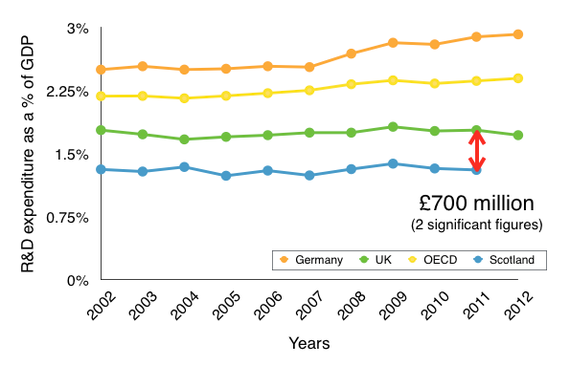Key to my decision regarding Scottish independence, as an academic researcher, are facts and figures regarding Scotland's current Research and Development (R&D) performance as part of the UK. Until very recently I was part of what is probably a majority that believes that Scotland is doing disproportionately well in terms of funding for its research institutions when compared with its proportional share of tax revenues or population share. However, my recent focus on the real data, driven by work with Dr. Stephen Watson, my former lecturer in Mathematics at the University of Glasgow and Chair of the Academics for Yes group, has enlightened me to a reality which is in stark contrast to this preconceived notion.
The truth is, as evidence by the very recently published report 'Research and Innovation in an Independent Scotland', that Westminster is presiding over a huge and widening gap in terms of Scotland's current R&D funding picture when compared with figures for the UK as a whole. We find that evidence given to date for the strength Scotland gains as a member of the union, in terms of research funding, is rather thin on the group. Often what we have seen until now represents, at its worst, little more than the carefully cherry picking of one or two data-points from the overall Scottish Research and Development picture.
The main point is simple. When we consider Scotland's Gross Research and Development Expenditure, all private and public funding on R&D, as a proportion of our GDP, a statistic otherwise known as 'Research Intensity', we see that at 1.31% for 2012-13, we not only fall behind the UKs performance of 1.7%, but well below the EU-28 average of 2.8% and the performance of many similarly-sized, comparable economies such as Belgium (2.24%), Denmark (2.99%), Finland (3.55%) and Sweden (3.41%). In real terms this difference between Scotland's current performance and that of the UK equates to a funding gap of £700m in 2012-13 and this is a gap that has been allowed to widen in recent years.
What we see is a clear oversight in terms of UK funding provision in Scotland. There are two main components to arriving at this conclusion. The first considers the usual focus of conversation on this issue, Research Council funding figures. We find that when taken in full, rather than cherry-picked as is often done by both the Treasury and the wider 'No' campaign, these figures show an overall funding differential in favour of Scotland of just £42m per year on average between 2005 and 2013, a mere 0.08% of Scotland's tax revenue for 2012-13 (Source: GERS, 2014). Add to this perspective the overall underspend we see in Science in Technology in Scotland as compared with the UK of more than £70m on average, and the very low percentage (5.4%) of total UK Business and Enterprise Research and Development (BERD) funding reaching Scotland, and we see a net result which demonstrates a huge underspend in Scotland when compared to the UK average. In fact this underspend goes from large to huge when we compare levels of Research Intensity in Scotland with either the OECD average or, indeed, those funding levels of those similarly-sized, comparable nations of the EU quoted above; each reported to perform very strongly in this area by Nesta.

Now it is my great regret that this revelation could not come sooner in terms of the wider debate but what I would ask is that anyone reading this does what they can to share the Academics for Yes report: AYes_Research_and_Innovation_iScotland.PDF. Link, print, copy and circulate this data as far and wide as you can get it. Don't let the cherry-picked data from the `No' campaign be all that a voter tomorrow has at their disposal when they reach the polling booth!